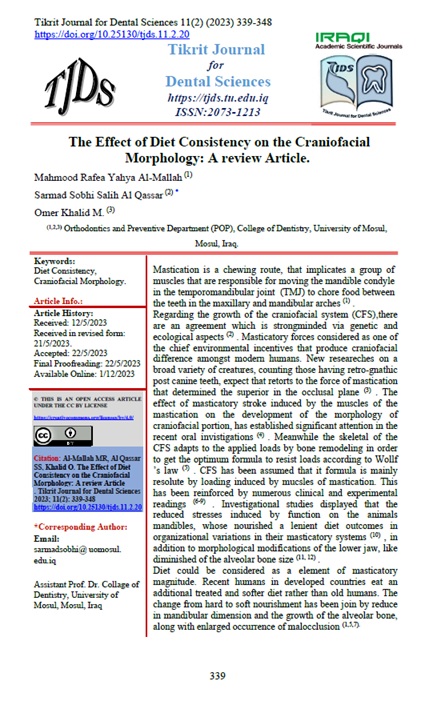The Effect of Diet Consistency on the Craniofacial Morphology: A review Article.
Mahmood Rafea Yahya Al-Mallah
Orthodontics and Preventive Department (POP), College of Dentistry, University of Mosul, Mosul, Iraq.
Sarmad Sobhi Salih Al Qassar
Orthodontics and Preventive Department (POP), College of Dentistry, University of Mosul, Mosul, Iraq.
Omer Khalid M.
Orthodontics and Preventive Department (POP), College of Dentistry, University of Mosul, Mosul, Iraq.
DOI: https://doi.org/10.25130/tjds.11.2.20
Keywords: Diet Consistency, Craniofacial Morphology
Abstract
Mastication is a chewing route, that implicates a group of muscles that are responsible for moving the mandible condyle in the temporomandibular joint (TMJ) to chore food between the teeth in the maxillary and mandibular arches (1) .
Regarding the growth of the craniofacial system (CFS),there are an agreement which is strongminded via genetic and ecological aspects (2) . Masticatory forces considered as one of the chief environmental incentives that produce craniofacial difference amongst modern humans. New researeches on a broad variety of creatures, counting those having retro-gnathic post canine teeth, expect that retorts to the force of mastication that determined the superior in the occlusal plane (3) . The effect of masticatory stroke induced by the muscles of the mastication on the development of the morphology of craniofacial portion, has established significant attention in the recent oral invistigations (4) . Meanwhile the skeletal of the CFS adapts to the applied loads by bone remodeling in order to get the optimum formula to resist loads according to Wollf ’s law (5) . CFS has been assumed that it formula is mainly resolute by loading induced by mucsles of mastication. This has been reinforced by numerous clinical and experimental readings (6-9) . Investigational studies displayed that the reduced stresses induced by function on the animals mandibles, whose nourished a lenient diet outcomes in organizational variations in their masticatory systems (10) , in addition to morphological modifications of the lower jaw, like diminished of the alveolar bone size (11, 12) .
Diet could be considered as a element of masticatory magnitude. Recent humans in developed countries eat an additional treated and softer diet rather than old humans. The change from hard to soft nourishment has been join by reduce in mandibular dimension and the growth of the alveolar bone, along with enlarged occurrence of malocclusion (1,5,7).




